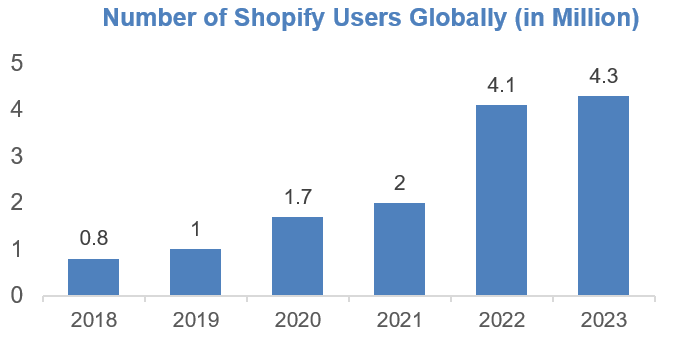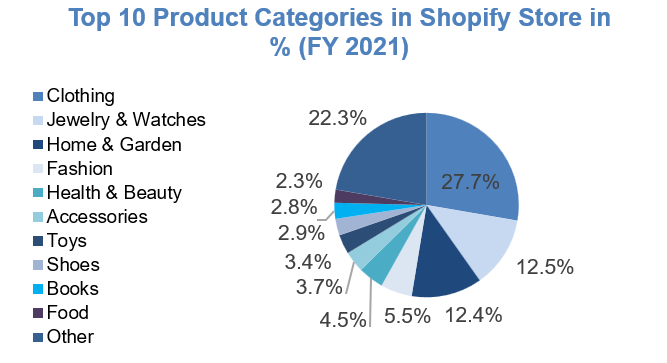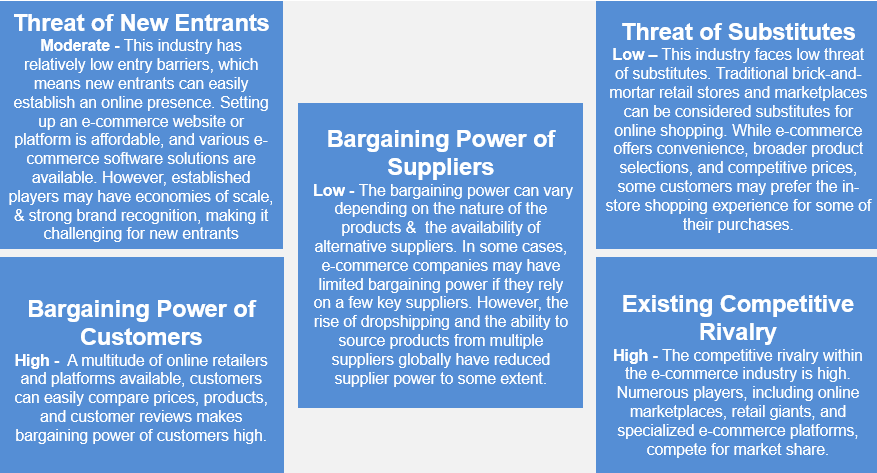Global E-commerce Industry
E-commerce (electronic commerce) is the buying and selling of goods and services, or the transmitting of funds or data, over an electronic network, primarily the internet.
Global Market Overview
The global e-commerce market size reached $16.6 trillion in 2022 and is expected to reach $70.9 trillion by 2028, exhibiting a CAGR of 27.38% during 2022-2028 1. The e-commerce market size in the United States attained a value of $1.27 trillion in 2020 2

The e-commerce market in the UAE is projected to grow by 8.57% (2023-2027), resulting in a market volume of AED 60 billion ($16.37 billion) in 2027 3
Key Player - Shopify
Shopify is a cloud-based, ‘all-in-one’ e-commerce platform that lets users build and run an online store. Shopify has generated over $700 billion in sales during its 17 years of operation with a total revenue of $5.6 billion in 2022 7.

Shopify is used by online sellers in over 175 countries around the world, with 63% of Shopify stores estimated to be based in the US 7. The total market share of Shopify and Shopify Plus combined is 11.2%, meaning 1 out of 10 eCommerce stores are built on Shopify 4. Shopify has over 4.4 million live websites 4

M &A Activity in the Industry
M&A activity in this industry includes notable deals such as Shopify app Okendo landing AED 19 million ($5.3 million) in a seed round 5
Tapcart, a ‘Shopify for mobile apps,’ raised USD 50 million in Series B funding 6
Porter’s Five Forces for the E-commerce Industry

Threat of New Entrants
Moderate - This industry has relatively low entry barriers, which means new
entrants can easily establish an online presence. Setting up an e-commerce
website or platform is affordable, and various e-commerce software solutions
are available. However, established players may have economies of scale, &
strong brand recognition, making it challenging for new entrants.
Bargaining Power of Suppliers
Low - The bargaining power can vary depending on the nature of the products &
the availability of alternative suppliers. In some cases, e-commerce companies
may have limited bargaining power if they rely on a few key suppliers.
However, the rise of dropshipping and the ability to source products from
multiple suppliers globally have reduced supplier power to some extent.
Bargaining Power of Customers
High - A multitude of online retailers and platforms available, customers can
easily compare prices, products, and customer reviews, which makes bargaining
power of customers high.
Threat of Substitutes
Low – This industry faces low threat of substitutes. Traditional brick-and-
mortar retail stores and marketplaces can be considered substitutes for online
shopping. While e-commerce offers convenience, broader product selections, and
competitive prices, some customers may prefer the in-store shopping experience
for some of their purchases.
Existing Competitive Rivalry
High - The competitive rivalry within the e-commerce industry is high.
Numerous players, including online marketplaces, retail giants, and
specialized e-commerce platforms, compete for market share.
Sources
- https://www.researchandmarkets.com/reports/5732341/e-commerce-market-global-industry-trends#:
- https://www.globaldata.com/data-insights/retail-and-wholesale/market-value-of-e-commerce-in-united-states-of-america-2082923/
- https://www.statista.com/outlook/dmo/ecommerce/united-arab-emirates
- https://meetanshi.com/blog/shopify-statistics/
- https://refreshmiami.com/shopify-app-okendo-lands-5-3-million-seed-round-to-help-d2c-brands-scale/
- https://techcrunch.com/2021/06/28/tapcart-a-shopify-for-mobile-apps-raises-a-50-million-series-b/
- https://www.stylefactoryproductions.com/blog/shopify-statistics
- https://blog.shopgram.io/top-product-categories-in-shopify-2021/